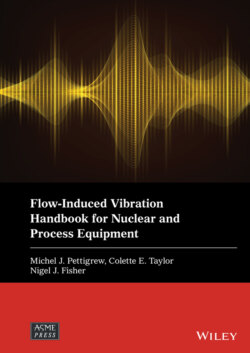Читать книгу Flow-Induced Vibration Handbook for Nuclear and Process Equipment - Группа авторов - Страница 16
1.3 Dynamics of Process System Components 1.3.1 Multi‐Span Heat Exchanger Tubes
ОглавлениеFrom a mechanical dynamics point of view, heat exchanger and steam generator tubes are multi‐span beams clamped at the tubesheet and held at the baffle supports with varying degree of constraint (see Fig. 1-12). The degree of constraint depends on support geometry and, particularly, on tube‐to‐support clearance. Heat exchanger dynamics is inherently a non‐linear phenomenon since it depends largely on the interaction (impacting and sliding) between a particular tube and its supports. This non‐linearity is particularly important since it governs the evaluation of damping at the supports and the prediction of fretting‐wear damage to the tube.
Such analysis requires time domain non‐linear simulation of the tube dynamics in which the details of sliding‐friction, impact, viscous‐shear and squeeze‐film forces between tube and tube supports are modelled. Unfortunately, non‐linear simulations are difficult and some of the detailed information is lacking. Furthermore, the required non‐linear analysis is not yet in the form of a practical design tool. Some progress has been made in this area with the development of codes, such as VIBIC (Fisher et al, 1992), H3DMAP (Sauvé et al, 1987) and EPRI SG FW (Rao et al, 1988) to predict fretting wear of heat exchanger tubes.
In the future, we believe that all vibration analyses will consider non‐linear simulation of the dynamic interaction between tubes and supports and will include a fretting‐wear damage prediction. This kind of analysis is now done by specialists for very critical or very expensive components, such as nuclear steam generators. Fretting‐wear damage prediction is discussed in Chapter 12.
For the time being, quasi‐linear vibration analyses are used by the industry for most heat exchangers. Quasi‐linear analysis requires the formulation of tube‐to‐support dynamic interaction forces, such as damping, in terms of equivalent linear values. We have found this approach to be reasonable in practice for the prediction of overall tube vibration response and critical velocities for fluidelastic instability. Such analysis is adequate to eliminate most vibration problems. However, long‐term fretting‐wear damage and tube life can only be predicted in an approximate manner. Tube vibration measurements in real heat exchangers show generally good agreement between measured and predicted frequencies using the quasi‐linear approach.
Fig. 1-12 Multi‐Span Heat Exchanger Tube with N Spans and N‐1 Clearance Supports.
